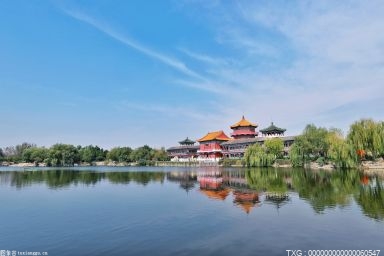A Glimpse of Ancient Capital Ruins in Luoyang③|Capital Ruins of Eastern Zhou Dynasty
走进洛阳大遗址③|探寻“天子驾六”品味东周文化
Editor"s note:Luoyang city in Central China"s Henan province is an important birthplace of Chinese civilization, serving as a capital for more than 1,500 years in Chinese history. Along the Luohe River on the Yiluo Plain, a core area of Luoyang Basin, are located 5 ancient city ruins, namely Yanshi Shang Dynasty Capital Ruins, Erlitou Ruins, Capital Ruins of Dynasties of Eastern Han, Former Wei, Western Jin and Later Wei, Capital Ruins from Sui to Tang Dynasties, and Capital Ruins of Eastern Zhou Dynasty. Such a dense distribution of capital ruins is rarely seen in the world. At present, Luoyang is accelerating protection of major ruins and construction of "Five Major Capital Ruins Museum Cluster". Starting on April 29, we are launching 5 bilingual video stories about the ruins mentioned above under the theme of"A Glimpse of Ancient Capital Ruins in Luoyang"to help you know more about Luoyang, Henan and China. Here is the third story of the series:Capital Ruins of Eastern Zhou Dynasty.
 (资料图)
(资料图)
编者按:作为华夏文明的重要发源地,洛阳拥有1500多年建都史。在洛阳盆地腹心的伊洛平原上,沿洛河一线从东到西排列着偃师商城遗址、二里头遗址、汉魏洛阳城遗址、隋唐洛阳城遗址和东周王城遗址“五大都城遗址”,如此密集的都城分布举世罕见。目前,洛阳正加快推进大遗址保护和“五大都城遗址博物馆群”建设。4月29日起,大河网推出“走进洛阳大遗址”5期双语特别报道,聚焦洛阳“五大都城遗址”,以双语短视频的形式,向外讲好古都洛阳故事,让更多外国友人在行走河南中了解历史、读懂中国。今日推出第3期:《探寻“天子驾六” 品味东周文化》。
Click on the video
Ji Yijiu, King Pingwang of the Zhou Dynasty (1046-256 BC), relocated his capital from Haojing (today"s Xi"an city of Northwest China"s Shaanxi province) to Luoyi (today"s Luoyang city of Central China"s Henan province) in 770 BC, marking the beginning of the Eastern Zhou Dynasty (770-256 BC) in Chinese history. The capital ruins of the Eastern Zhou Dynasty are distributed in the area from Wangcheng Park to Luoyang Department Store in Xigong district, Luoyang city.
公元前770年,周平王东迁洛邑,建都于东周王城。东周王城遗址位于今洛阳市西工区王城公园至百货大楼一带,是东周时期周王都城所在地。
A tomb of the Eastern Zhou Dynasty. [Photo provided to dahe.cn]
In Chinese history, there are 25 kings that ruled the Eastern Zhou Dynasty. To facilitate historical research, it is further divided into two periods by historians: the Spring and Autumn (770-476 BC) and the Warring States (475-221 BC). The archaeological surveys and excavations suggest that the vast majority of the capital site is located in the central and western parts of Xigong district and well-preserved except its southeastern part destroyed by the Luohe River. Covering an area of 14 square meters, the capital site is basically square in shape with the Mangshan Mountain in its north while the Luohe River in its south. Outside the rammed-earth walls was a moat. The wall remains are easily found near Wunyuzhong village which located in an elevated position.
历史上的东周共传25王,分春秋和战国两个时期。经文物调查和考古发掘证实,其大部分位于今洛阳市西工区中西部,除东南角被洛河冲毁外,其余部分基本完好。东周王城遗址北依邙山,南临洛河,平面大体呈正方形,总面积14平方公里,四周为夯土城墙,墙外有护城河。今五女冢村附近地势较高,至今地面上仍能看到残存的东周王城城墙。
A cultural relic of the Warring States period. [Photo provided to dahe.cn]
To protect the capital site, a public park was built in its center, named Wangcheng (imperial city in English). Later, many important cultural relics were discovered, including many large horse and chariot pits as well as a large cemetery at the eastern part of the site, presenting a general picture of the capital.
为保护东周王城遗址,洛阳在城址的中心建设了王城公园,并对游人开放。以后,又多次在遗址区域有重要发现,特别是在王城东部发现了大型车马坑和大型墓葬,解开了东周王城陵区之谜,为了解东周王城的全貌提供了宝贵资料。
1 chariot with 6 horse. [Photo provided to dahe.cn]
It is worth noting that 18 horse and chariot pits were discovered in 2002. In the largest one, archaeologists found 26 chariots and 70 horse remains, including 1 chariot with 6 horse remains, which confirms the accuracy of a historical text describing a king riding in a chariot driven by six steeds.
值得一提的是,2002年,考古工作者先后发现了18座车马坑,并在规模最大的车马坑内清理出马车26辆、马70匹。其中,在一辆马车前面对称摆放着6匹马的骨骸,这印证了古文献当中“天子驾六”的记述。(编译/赵汉青 杨佳欣 视频/何蒙贺 审校/焦丹)
关键词:










